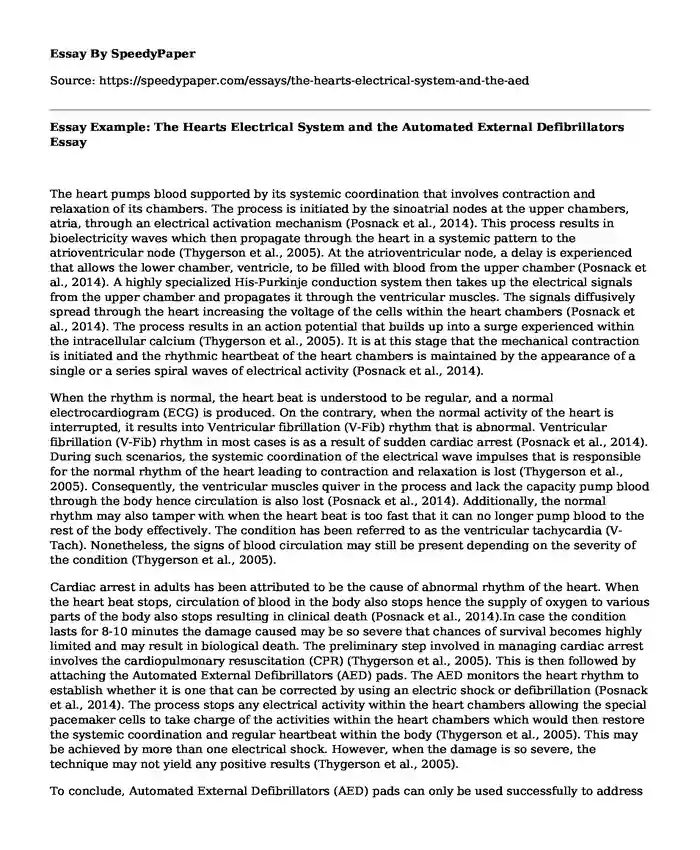
| Type of paper: | Essay |
| Categories: | Health and Social Care Medicine Technology |
| Pages: | 3 |
| Wordcount: | 658 words |
The heart pumps blood supported by its systemic coordination that involves contraction and relaxation of its chambers. The process is initiated by the sinoatrial nodes at the upper chambers, atria, through an electrical activation mechanism (Posnack et al., 2014). This process results in bioelectricity waves which then propagate through the heart in a systemic pattern to the atrioventricular node (Thygerson et al., 2005). At the atrioventricular node, a delay is experienced that allows the lower chamber, ventricle, to be filled with blood from the upper chamber (Posnack et al., 2014). A highly specialized His-Purkinje conduction system then takes up the electrical signals from the upper chamber and propagates it through the ventricular muscles. The signals diffusively spread through the heart increasing the voltage of the cells within the heart chambers (Posnack et al., 2014). The process results in an action potential that builds up into a surge experienced within the intracellular calcium (Thygerson et al., 2005). It is at this stage that the mechanical contraction is initiated and the rhythmic heartbeat of the heart chambers is maintained by the appearance of a single or a series spiral waves of electrical activity (Posnack et al., 2014).
When the rhythm is normal, the heart beat is understood to be regular, and a normal electrocardiogram (ECG) is produced. On the contrary, when the normal activity of the heart is interrupted, it results into Ventricular fibrillation (V-Fib) rhythm that is abnormal. Ventricular fibrillation (V-Fib) rhythm in most cases is as a result of sudden cardiac arrest (Posnack et al., 2014). During such scenarios, the systemic coordination of the electrical wave impulses that is responsible for the normal rhythm of the heart leading to contraction and relaxation is lost (Thygerson et al., 2005). Consequently, the ventricular muscles quiver in the process and lack the capacity pump blood through the body hence circulation is also lost (Posnack et al., 2014). Additionally, the normal rhythm may also tamper with when the heart beat is too fast that it can no longer pump blood to the rest of the body effectively. The condition has been referred to as the ventricular tachycardia (V-Tach). Nonetheless, the signs of blood circulation may still be present depending on the severity of the condition (Thygerson et al., 2005).
Cardiac arrest in adults has been attributed to be the cause of abnormal rhythm of the heart. When the heart beat stops, circulation of blood in the body also stops hence the supply of oxygen to various parts of the body also stops resulting in clinical death (Posnack et al., 2014).In case the condition lasts for 8-10 minutes the damage caused may be so severe that chances of survival becomes highly limited and may result in biological death. The preliminary step involved in managing cardiac arrest involves the cardiopulmonary resuscitation (CPR) (Thygerson et al., 2005). This is then followed by attaching the Automated External Defibrillators (AED) pads. The AED monitors the heart rhythm to establish whether it is one that can be corrected by using an electric shock or defibrillation (Posnack et al., 2014). The process stops any electrical activity within the heart chambers allowing the special pacemaker cells to take charge of the activities within the heart chambers which would then restore the systemic coordination and regular heartbeat within the body (Thygerson et al., 2005). This may be achieved by more than one electrical shock. However, when the damage is so severe, the technique may not yield any positive results (Thygerson et al., 2005).
To conclude, Automated External Defibrillators (AED) pads can only be used successfully to address the challenge of cardiac arrest on the onset before severe damage is caused.
References
Posnack, N. G., Jaimes III, R., Asfour, H., Swift, L. M., Wengrowski, A. M., Sarvazyan, N., & Kay, M. W. (2014). Bisphenol A Exposure and Cardiac Electrical Conduction in Excised Rat Hearts. Environmental Health Perspectives, 122(4), 384-390.
Thygerson, A. L., Gulli, B., Thygerson, A. L., American Academy of Orthopaedic Surgeons., & American College of Emergency Physicians. (2005). CPR and AED. Sudbury, Mass: Jones and Bartlett Publishers.
Cite this page
Essay Example: The Hearts Electrical System and the Automated External Defibrillators. (2019, Nov 07). Retrieved from https://speedypaper.com/essays/the-hearts-electrical-system-and-the-aed
Request Removal
If you are the original author of this essay and no longer wish to have it published on the SpeedyPaper website, please click below to request its removal:
- Essay Sample on How Media Influences Public Opinion on Smoking
- Essay Example: What Is Osteoporosis and Why Does It Occur
- Free Essay on the Extent of the Digital Divide
- Free Essay Describing Disability Development History
- Free Essay Describing Theories of Lifespan Development
- Essay Example on Bipolar Disorder: Abnormal Psychology in the News
- The Rationale for Pursuing the Nursing Profession - Essay Sample
Popular categories




